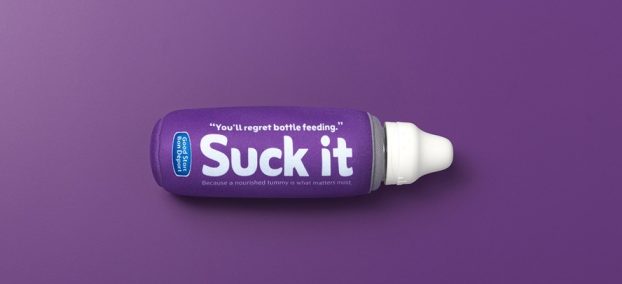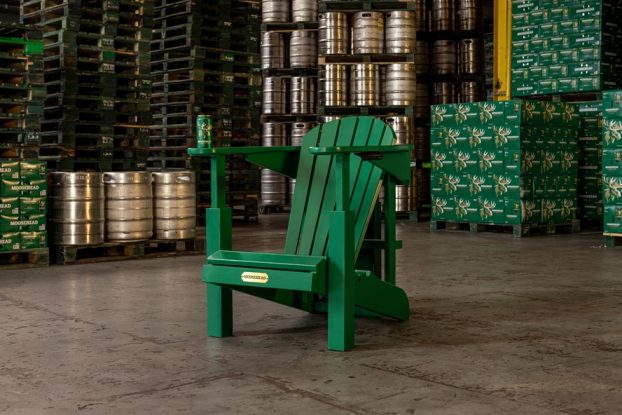When it comes to creating new and different vehicles for advertisers, it can be argued that out-of-home is the last bastion of true innovation. In recent years, the medium has seen a proliferation of non-traditional products. Here, Wendy Cuthbert takes a look at some of the most noteworthy.
It’s not often that you find a public space that could actually use a bit of advertising to spruce it up. But that’s exactly what Brad Golden, president of Parkad Media, found himself thinking whenever he drove through an underground parking lot.
A former architect accustomed to looking at city spaces with a critical eye, Golden says parking garages are unnecessarily dreary. What’s worst about them, he contends, is the fact that they don’t even acknowledge the presence of human beings.
Yet there are human beings there, at any time of day or night. And if there’s one thing they share in common, it’s a willingness to pay a premium for the luxury of parking in an enclosed space. ‘It’s a very desirable audience,’ Golden says.
That, in a nutshell, is what led to his decision to start Parkad, a company offering an advertising medium for parking garages called wayLIGHT. The wayLIGHT system combines orientation information with backlit displays designed to showcase an advertiser’s message.
The system was introduced in March at Toronto’s upscale Hazelton Lanes parkade.
A wayLIGHT system will also be installed in the Toronto Eaton Centre parkade in July, and Golden plans to roll out the concept nationally as soon as possible.
In parking garages serving malls or department stores, advertisers have the opportunity to directly influence purchase decisions, he says. And in commercial facilities such as those serving downtown bank towers, there’s the chance for office suppliers, luxury goods providers and business-to-business advertisers to reach those lucrative MOPEs (managers, owners, professionals and executives).
Golden says the system improves the appearance of garages and adds light, increasing the sense of safety. And the way-finding information virtually guarantees that the ad copy will be read.
The intrusiveness of the medium also works in the advertiser’s favour, says Golden. ‘You don’t have much else to look at in an underground parking garage.’
Another environment short on visual stimulation is the elevator – which is what furnished the inspiration for the launch of Toronto-based Elevator News Network (ENN) in 1998.
ENN’s network of video monitors in downtown Toronto office towers broadcasts continuously updated news, weather, sports, stock market and traffic reports – along with ads, of course.
Peter Irwin, president of ENN, says this is the first medium that delivers the downtown office community – an audience with an average annual income of $84,000 – to advertisers.
According to ENN research, the average office tower employee spends 81 minutes a month travelling up and down in elevators – essentially trapped in a box with no distractions.
When they’re descending, it’s often with the intent of buying something (lunch, for example). On the way up, they may be contemplating a business decision – which, again, may involve making a purchase.
ENN currently has monitors in 260 Toronto office towers, and there are plans to invade the Calgary market in August. Irwin says the network is ‘site-addressable,’ which means that advertisers can place different messages in different areas of the city. Clearnet’s ads, for example, promote the retail locations closest to each ENN site.
ENN combines the best of all media worlds, he says. While it has the characteristics of television and the programming style of radio, it also offers the demographic certainty of specialty print publications.
Terry Sheehy, senior vice-president of media services for Leo Burnett’s media division, Starcom Canada, says the place-based approach to out-of-home advertising represented by ENN and Parkad has grown by leaps and bounds in recent years.
It’s an attractive option for advertisers interested in zeroing in on a particular target group, he says. Still, not all clients are wildly enthusiastic about such non-traditional vehicles, citing concern about the difficulty of obtaining research, and the potential for backlash on the part of consumers.
‘They’re difficult sells to some clients,’ Sheehy says.
It always takes time for a new media vehicle to build some momentum, affirms Claude Breault, manager of communications for Zoom Media in Montreal. That’s what the company found when it first introduced its network of washroom ads in bars and nightclubs. And it’s having the same experience with the introduction of its newest products, MedMedia and The Golf Network.
MedMedia, which launched in February, offers clients the opportunity to buy ad space in health care establishments, such as doctors’ waiting rooms and public areas in hospitals. Zoom has hammered out deals to install faces in approximately 100 facilities in Quebec and Ontario.
Breault says MedMedia is ideal for any advertiser interested in reaching a health-conscious consumer. Zoom is now in the process of trying to drum up interest among pharmaceutical companies and packaged goods manufacturers offering health and beauty products.
The Golf Network, which launched in April, offers washroom and locker-room advertising panels in 76 golf clubs in Quebec, and another 14 in Ontario.
Breault says golfers represent a desirable target. ‘They have money and they spend a lot on luxury products,’ he explains.
Breault is confident MedMedia and The Golf Network will ultimately carve out a respectable place for themselves in the out-of-home arena. For one thing, they’re much more targeted than traditional out-of-home, which means an advertiser’s message is rarely wasted. And they offer the opportunity to target not just based on demographics, but on psychographics as well.
‘These are for the client who doesn’t want to reach an age group, but an interest group,’ he says.
Not all new outdoor products are so targeted. Earlier this year, for example, Gallop & Gallop introduced CashMedia, an ATM advertising network that offers ad space on CIBC machines in convenience stores and Petro-Canada superstores.
Greg Gallop, general manager of Gallop & Gallop Advertising’s outdoor division, says the company made the deal with the bank in order to extend its existing convenience store network (Flashmedia) into the Toronto-based Silcorp chain (which owns Becker’s, Mac’s and Mike’s Mart outlets).
Clients can place ads on the body of the bank machines in poster form, and insert them within the messages onscreen. Coupons can also be printed out on the ATM user’s receipt, although no advertiser has yet signed on to do this.
While convenience stores are often perceived as teen hangouts, they attract just about every other type of consumer as well, Gallop says.
The CashMedia network extends across Canada. While a number of regional advertisers have expressed interest, the company is prepared to accept only short-term deals with them, because it doesn’t want to cut off any national advertising opportunities.
Another out-of-home player to introduce new mass-audience products is OMG Media of Concord, Ont.
The concept for OMG’s Info-Bar and Info-Box products originated in Europe, says Loredana Oliveti, the company’s executive vice-president.
First launched in 1996, the Info-Bar is a stainless steel frame placed along sidewalks on the curb, to channel pedestrian traffic. The ads appear within small tubes on the structure.
There are approximately 300 Info-Bars now in place in the Toronto suburbs of Etobicoke and Vaughn, Oliveti says. Advertisers include the Pizza Pizza and Mr. Sub chains.
The Info-Box, meanwhile, is a public waste and recycling receptacle that can also feature an advertiser’s message.
Municipalities receive some of the ad revenue, in exchange for recycling the waste that’s dumped into the Info-Box.
Oliveti says the product taps into public concern about the environment, and helps send out a positive message about the advertiser.
Laudable as that may be, Info-Box has yet to attract much client interest. Most of the users so far have been local advertisers. Still, OMG is confident that the concept will catch on, and is currently working on deals to place the boxes in Montreal and Guelph, Ont.
Also in this report:
– Dundas Square the ‘Stanley Cup’ of outdoor p.19
– New Brunswick dips ad toe into warmer waters: Campaign targeting Quebecers sells sun, sand and surf p.23
– Spotlight on Creative p.25























